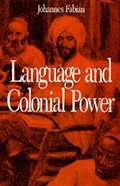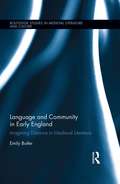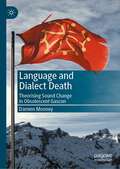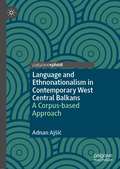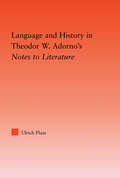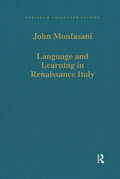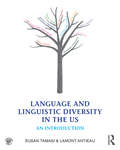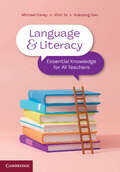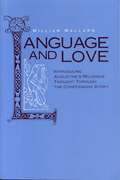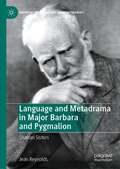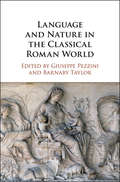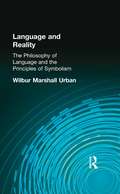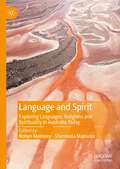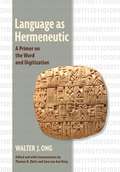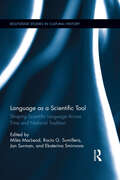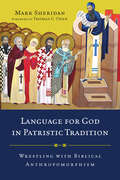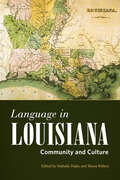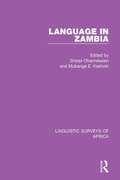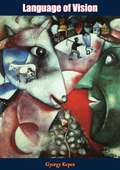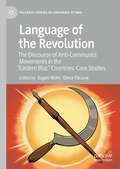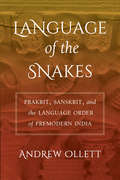- Table View
- List View
Language and Colonial Power: The Appropriation of Swahili in the Former Belgian Congo, 1880-1938
by Johannes FabianAmong the preconditions for establishing colonial authority was communication with the colonised. Verbal exchanges depended on a shared communicative praxis providing common ground on which unilateral claims could be imposed. Use of, and control over, verbal means of communication were needed to maintain regimes - military, religious-ideological, economic - in power. In the Belgian Congo brutal physical force never ceased to be exercised. In this study Professor Fabian examines the more subtle uses of power through controls on communication, by looking at the history of Swahili as it spread from the East Coast to Central Africa and demonstrating connections between -changing forms of colonial power and the development of policies towards Swahili. Using a wide range of sources, including numerous and sometimes obscure vocabularies, he combines concepts derived from literary theory and sociolinguistics to uncover, through the flaws and failures of these texts, deep-seated attitudes to language and communication.
Language and Community in Early England: Imagining Distance in Medieval Literature
by Emily ButlerThis book examines the development of English as a written vernacular and identifies that development as a process of community building that occurred in a multilingual context. Moving through the eighth century to the thirteenth century, and finally to the sixteenth-century antiquarians who collected medieval manuscripts, it suggests that this important period in the history of English can only be understood if we loosen our insistence on a sharp divide between Old and Middle English and place the textuality of this period in the framework of a multilingual matrix. The book examines a wide range of materials, including the works of Bede, the Alfredian circle, and Wulfstan, as well as the mid-eleventh-century Encomium Emmae Reginae, the Tremulous Hand of Worcester, the Ancrene Wisse, and Matthew Parker’s study of Old English manuscripts. Engaging foundational theories of textual community and intellectual community, this book provides a crucial link with linguistic distance. Perceptions of distance, whether between English and other languages or between different forms of English, are fundamental to the formation of textual community, since the awareness of shared language that can shape or reinforce a sense of communal identity only has meaning by contrast with other languages or varieties. The book argues that the precocious rise of English as a written vernacular has its basis in precisely these communal negotiations of linguistic distance, the effects of which were still playing out in the religious and political upheavals of the sixteenth century. Ultimately, the book argues that the tension of linguistic distance provides the necessary energy for the community-building activities of annotation and glossing, translation, compilation, and other uses of texts and manuscripts. This will be an important volume for literary scholars of the medieval period, and those working on the early modern period, both on literary topics and on historical studies of English nationalism. It will also appeal to those with interests in sociolinguistics, history of the English language, and medieval religious history.
Language and Complex Systems
by William A. Kretzschmar Jr.An understanding of language as a complex system helps us to think differently about linguistics, and helps us to address the impact of linguistic interaction. This book demonstrates how the science of complex systems changes every area of linguistics: how to make a grammar, how to think about the history of language, how language works in the brain, and how it works in social settings. Kretzschmar argues that to construct the best grammars of languages it is necessary to understand the complex system of speech. Each chapter makes specific recommendations for how linguists should manage empirical data in order to form better generalizations about a language and its varieties. The book will be welcomed by students and scholars working in linguistics and English language, especially the study of language variation and the historical development of English.
Language and Dialect Death: Theorising Sound Change in Obsolescent Gascon
by Damien MooneyThis book offers a systematic acoustic phonetic analysis of both language and dialect death in the region of Béarn, southwestern France. Focusing on Béarnais, a localised dialect of Gascon which is under pressure from French, the author explores the socio-political process of language shift, whereby members of a speech community cease to speak their indigenous language in favour of an incoming dominant language. Gascon is at an advanced stage of this process, making its remaining speakers excellent candidates for the study of language obsolescence, and this unique study will be of interest to researchers working in a broad range of disciplines, including language variation and change, language and dialect contact, Occitan and French, sociophonetics and phonology.
Language and Ethnonationalism in Contemporary West Central Balkans: A Corpus-based Approach
by Adnan AjšićThis book uses a specialized corpus of public language-related discourse to investigate links between language ideologies and ethnonationalism in contemporary West Central Balkans. Despite a century and a half of shared linguistic history, the nations making up the central part of former Yugoslavia continue to debate the ownership over the common language, creating much animosity, some legal issues, and often absurd circumstances. At the heart of the ongoing language debate over Central South Slavic is the belief in language as the cornerstone of ethnonational identity and the legitimacy of ethnic groups’ claims to sovereignty. Given a history of conflict and the recent resurgence in extreme ethnonationalism, an understanding of ethnolinguistic contestation in the region is as important as ever. This book will be of interest to social scientists working in fields as diverse as (applied) linguistics, anthropology, media studies, political science, sociology and history, as well as other scholars with an interest in language and society.
Language and History in Adorno's Notes to Literature (Studies In Philosophy Ser.)
by Ulrich PlassLanguage and History in Theodor W. Adorno's Notes to Literature explores Adorno’s essays on literature as an independent contribution to his aesthetics with an emphasis on his theory and practice of literary interpretation. Essential to Adorno’s essays is his unorthodox treatment of language and history and his elaboration of the links between the two. One of Adorno’s major but often-neglected claims is that truth is relative to its historical medium, language. Adorno persistently and creatively tries to narrow the gulf between truth and expression, philosophy and rhetoric, and his essays on literature are practical examples of his effort to critically rescue the rhetorical dimension of philosophy. Rather than relying exclusively on aesthetic concepts inherited from his predecessors in the Western tradition (Kant, Hegel, Nietzsche, Kierkegaard), Adorno’s essays seek to transgress and transcend the conceptual limitations of aesthetic discourse by appropriating a non-conceptual, metaphorical vocabulary borrowed from the literary texts he investigates. Thus, Adorno’s interpretations of literature mobilize an alternative subterranean, primarily essayistic and fragmentary discourse on language and history that eludes the categories that tend to predominate his thinking in his major work, Aesthetic Theory. This book puts forth the claim that Adorno’s essays on literature are of central relevance for an understanding of his aesthetics because they challenge the conceptual limitations of philosophical discourse.
Language and History: Integrationist Perspectives (Routledge Advances in Communication and Linguistic Theory #Vol. 4)
by Nigel LoveWhen linguistics was first established as an academic discipline in the nineteenth century, it was envisaged as an essentially historical study. Languages were to be treated as historical objects, evolving through gradual but constant processes of change over long periods of time. In recent years, however, there has been much discussion by historians of a 'linguistic turn' in their own discipline, and, in linguistics, integrationist theory has mounted a radical challenge to the traditional notion of 'languages' as possible objects of inquiry.Language and History develops the integrationist critique of orthodox linguistics, while at the same time extending its implications to the field of history. By doing so, it throws light on what is now recognized by many historians to be a 'crisis' in their own discipline. Underlying the post-modernist scepticism about traditional forms of historiography, the integrationist approach reveals a more deep-seated problem concerning the interface between philosophy of history and philosophy of language. With chapters from a range of leading international contributors, Language and History represents a significant contribution to the developing work of the integrationists.
Language and Learning in Renaissance Italy: Selected Articles (Variorum Collected Studies)
by John MonfasaniLanguage was the Italian humanists’ stock-in-trade, rhetoric their core discipline. In this volume Professor Monfasani collects together his most important articles on these subjects. One group of these, including two review essays, focuses specifically on the humanist Lorenzo Valla and on his philosophy of language. The third section of the book opens out the coverage of Italian Renaissance cultural history and includes studies of several new texts - among them a description of the decoration of the Sistine Chapel, and a call for press censorship - and of the religious culture of mid-15th-century Rome. Le langage était l’instrumet de base des humanistes italiens, la rhétorique leur discipline de fond. Dans ce volume, le professeur Monfasani rassemble ses articles les plus importants sur le sujet . Un groupe d’entre eux, comprenant deux comptesrendus, se concentre spécifiquement sur l’humaniste Lorenzo Valla et sur sa philosophie du langage. La troisième section du recueil élargit le champ de connaissance de l’histoire culturelle de la Renaissance italienne et inclus des études de plusieurs textes nouveaus - parmi ceux-ci, une description de la décoration intérieure de la chapelle Sixtine et un appel à la censure de la presse -, ainsi que de la culture religieuse romaine au milieu du 15e siècle.
Language and Linguistic Diversity in the US: An Introduction
by Lamont Antieau Susan TamasiThis highly engaging textbook presents a linguistic view of the history, society, and culture of the United States. It discusses the many languages and forms of language that have been used in the US - including standard and nonstandard forms of English, creoles, Native American languages, and immigrant languages from across the globe - and shows how this distribution and diversity of languages has helped shape and define America as well as an American identity. The volume introduces the basic concepts of sociolinguistics and the politics of language through cohesive, up-to-date and accessible coverage of such key topics as dialectal development and the role of English as the majority language, controversies concerning language use in society, languages other than English used in the US, and the policies that have directly or indirectly influenced language use. These topics are presented in such a way that students can examine the inherent diversity of the communicative systems used in the United States as both a form of cultural enrichment and as the basis for socio-political conflict. The author team outlines the different viewpoints on contemporary issues surrounding language in the US and contextualizes these issues within linguistic facts, to help students think critically and formulate logical discussions. To provide opportunities for further examination and debate, chapters are organized around key misconceptions or questions ("I don't have an accent" or "Immigrants don't want to learn English"), bringing them to the forefront for readers to address directly. Language and Linguistic Diversity in the US is a fresh and unique take on a widely taught topic. It is ideal for students from a variety of disciplines or with no prior knowledge of the field, and a useful text for introductory courses on language in the US, American English, language variation, language ideology, and sociolinguistics.
Language and Literacy: Essential Knowledge for All Teachers
by Xuesong Gao Michael Carey Vinh ToLiteracy is important foundational knowledge for all teaching areas and classroom settings. Language and Literacy covers the building blocks of literacy, as well as the developmental skills all pre-service and in-service teachers need to teach effectively and meaningfully across the Australian curriculum. Part one moves chronologically from the early years to the secondary years, covering phonological, phonemic and morphological awareness, word and sentence-level grammar, language use in social contexts, and a discussion on English language diversity and change. Part two introduces the metalanguage, content knowledge and teaching methods required to develop students' competence in vocabulary, text types and grammar, as well as oracy, reading, writing and critical literacy. Each chapter includes discussion points and further resources to engage students, with key terms linked to the comprehensive glossary. Written by experienced educators, Language and Literacy is an essential resource, offering a focused exploration of language and literacy knowledge for pre-service and in-service teachers.
Language and Love: Introducing Augustine's Religious Thought Through the Confessions Story (G - Reference, Information and Interdisciplinary Subjects)
by William MallardThis is the first work to combine an introduction to Augustine's Confessions with a larger outline of his mature theology. Mallard provides guidance for reading the narrative Confessions (Books I–IX) and at the same time, by certain extensions and comments, reveals the three major topical divisions within Augustine's thought: creation, salvation, and the City of God. Mallard is able to do this because Augustine's affirmation of the good of Creation, his view of the human will and God's grace (and the nature of evil), his sense of a religious people's identity and their hope, and his view of faith and reason were all essentially in place at the time of the Confessions.Mallard argues that Augustine was not "in search of himself" in a modern sense but in search of a language of prayer, praise, and truth that would locate him within God's grace. That language turned out to be the language of Incarnation, which remains compelling and inviting today. As a classic work, the Confessions is a monument to its own time, but it has striking resonances for our own. Mallard's interpretation will challenge readers to begin working out their own. The Confessions endures because it is a story that illumines the stories of many, even to the present day. To analyze how it is like, and unlike, modern experiences is to exercise both mind and heart. In that respect, Language and Love is a kind of theological meditation on the Confessions testing out a horizon of belief. Mallard views Augustine as a master of the spoken word in an age of broken and abused language and the Confessions as a historic masterpiece of rhetoric. He contends that Augustine is the ancestor of many today who offer social and political hope through fresh rhetorical vitality.
Language and Metadrama in Major Barbara and Pygmalion: Shavian Sisters (Bernard Shaw and His Contemporaries)
by Jean ReynoldsThis book focuses on two important topics in Shaw’s Major Barbara and Pygmalion that have received little attention from critics: language and metadrama. If we look beyond the social, political, and economic issues that Shaw explored in these two plays, we discover that the stories of the two “Shavian sisters”— Barbara Undershaft and Eliza Doolittle—are deeply concerned with performance and what Jacques Derrida calls “the problem of language.” Nearly every character in Major Barbara produces, directs, or acts in at least one miniature play. In Pygmalion, Henry Higgins is Eliza’s acting coach and phonetics teacher, as well as the star of an impromptu, open-air phonetics show. The language content in these two plays is just as intriguing. Did Eliza Doolittle have to learn Standard English to become a complete human being? Should we worry about the bad grammar we hear at Barbara Undershaft’s Salvation Army shelter? Is English losing its precision and purity? Meanwhile, in the background, Shaw keeps reminding us that language and theatre are always present in our everyday lives—sometimes serving as stabilizing forces, and sometimes working to undo them.
Language and Nature in the Classical Roman World
by Giuseppe Pezzini Barnaby TaylorA familiar theme in Greek philosophy, largely due to the influence of Plato's Cratylus, linguistic naturalism (the notion that linguistic facts, structures or behaviour are in some significant sense determined by nature) constitutes a major but under-studied area of Roman linguistic thought. Indeed, it holds significance not only for the history of linguistics but also for philosophy, stylistics, rhetoric and more. The chapters in this volume deal with a range of naturalist theories in a variety of authors including Cicero, Varro, Nigidius Figulus, Posidonius, and Dionysius of Halicarnassus. The result is a complex and multi-faceted picture of how language and nature were believed to interrelate in the classical Roman world.
Language and Reality: The Philosophy of Language and the Principles of Symbolism
by Wilbur Marshall UrbanFirst published in 2002. Routledge is an imprint of Taylor & Francis, an informa company.
Language and Revolution: Making Modern Political Identities (Cummings Center Series #Vol. 16)
by Igal HalfinThis work examines the role of language in forging the modern subject. Focusing on the idea of the "New Man" that has animated all revolutionaries, the present volume asks what it meant to define oneself in terms of one's class origins, gender, national belonging or racial origins.
Language and Spirit: Exploring Languages, Religions and Spirituality in Australia Today
by Robyn Moloney Shenouda MansourThis edited book explores stories of linguistic and spiritual identity in the urban and rural Australian landscape. It is an innovative mix of thirty six personal narratives and eleven research studies, which together offer accounts of the intersection of languages, religion and spirituality in people’s lives. Teachers of Indigenous languages speak of the critical connection between language revitalization, the spirituality of Country, and well-being. Both new and long-established diaspora individuals speak of the often complex but vital joint role of language and faith in belonging and heritage. The new dimension which the book brings to multilingualism is relevant to all complex global societies. Language and Spirit is ideal for both the general reader interested in community languages and interfaith issues, and academics in global intercultural studies and Applied Linguistics study wishing to gain a nuanced insight into the Language and Spirit intersection.
Language and linguistic contact in ancient Sicily
by Olga Tribulato"Within the field of ancient bilingualism, Sicily represents a unique terrain for analysis as a result of its incredibly rich linguistic history, in which 'colonial' languages belonging to branches as diverse as Italic (Oscan and Latin), Greek and Semitic (Phoenician) interacted with the languages of the natives (the elusive Sicel, Sicanian and Elymian). The result of this ancient melting-pot was a culture characterised by 'postcolonial' features such as ethnic hybridity, multilingualism and artistic and literary experimentation. While Greek soon emerged as the leading language, dominating official communication and literature, epigraphic sources and indirect evidence show that the minority languages held their ground down to the fifth century BCE, and in some cases beyond. The first two parts of the volume discuss these languages and their interaction with Greek, while the third part focuses on the sociolinguistic revolution brought about by the arrival of the Romans"--
Language as Hermeneutic: A Primer on the Word and Digitization
by Walter J. OngLanguage in all its modes—oral, written, print, electronic—claims the central role in Walter J. Ong’s acclaimed speculations on human culture. After his death, his archives were found to contain unpublished drafts of a final book manuscript that Ong envisioned as a distillation of his life’s work. This first publication of Language as Hermeneutic, reconstructed from Ong’s various drafts by Thomas D. Zlatic and Sara van den Berg, is more than a summation of his thinking. It develops new arguments around issues of cognition, interpretation, and language. Digitization, he writes, is inherent in all forms of "writing," from its early beginnings in clay tablets. As digitization increases in print and now electronic culture, there is a corresponding need to counter the fractioning of digitization with the unitive attempts of hermeneutics, particularly hermeneutics that are modeled on oral rather than written paradigms.In addition to the edited text of Language as Hermeneutic, this volume includes essays on the reconstruction of Ong’s work and its significance within Ong’s intellectual project, as well as a previously unpublished article by Ong, "Time, Digitization, and Dalí's Memory," which further explores language’s role in preserving and enhancing our humanity in the digital age.
Language as a Scientific Tool: Shaping Scientific Language Across Time and National Traditions (Routledge Studies in Cultural History)
by Miles MacLeod, Rocío G. Sumillera, Jan Surman and Ekaterina SmirnovaLanguage is the most essential medium of scientific activity. Many historians, sociologists and science studies scholars have investigated scientific language for this reason, but only few have examined those cases where language itself has become an object of scientific discussion. Over the centuries scientists have sought to control, refine and engineer language for various epistemological, communicative and nationalistic purposes. This book seeks to explore cases in the history of science in which questions or concerns with language have bubbled to the surface in scientific discourse. This opens a window into the particular ways in which scientists have conceived of and construed language as the central medium of their activity across different cultural contexts and places, and the clashes and tensions that have manifested their many attempts to engineer it to both preserve and enrich its function. The subject of language draws out many topics that have mostly been neglected in the history of science, such as the connection between the emergence of national languages and the development of science within national settings, and allows us to connect together historical episodes from many understudied cultural and linguistic venues such as Eastern European and medieval Hebrew science.
Language for God in Patristic Tradition: Wrestling with Biblical Anthropomorphism
by Mark SheridanLanguage for God in Patristic Tradition
Language in Louisiana: Community and Culture (America's Third Coast Series)
by Nathalie Dajko and Shana WaltonContributions by Lisa Abney, Patricia Anderson, Albert Camp, Katie Carmichael, Christina Schoux Casey, Nathalie Dajko, Jeffery U. Darensbourg, Dorian Dorado, Connie Eble, Daniel W. Hieber, David Kaufman, Geoffrey Kimball, Thomas A. Klingler, Bertney Langley, Linda Langley, Shane Lief, Tamara Lindner, Judith M. Maxwell, Rafael Orozco, Allison Truitt, Shana Walton, and Robin WhiteLouisiana is often presented as a bastion of French culture and language in an otherwise English environment. The continued presence of French in south Louisiana and the struggle against the language's demise have given the state an aura of exoticism and at the same time have strained serious focus on that language. Historically, however, the state has always boasted a multicultural, polyglot population. From the scores of indigenous languages used at the time of European contact to the importation of African and European languages during the colonial period to the modern invasion of English and the arrival of new immigrant populations, Louisiana has had and continues to enjoy a rich linguistic palate. Language in Louisiana: Community and Culture brings together for the first time work by scholars and community activists, all experts on the cutting edge of research. In sixteen chapters, the authors present the state of languages and of linguistic research on topics such as indigenous language documentation and revival; variation in, attitudes toward, and educational opportunities in Louisiana’s French varieties; current research on rural and urban dialects of English, both in south Louisiana and in the long-neglected northern parishes; and the struggles more recent immigrants face to use their heritage languages and deal with language-based regulations in public venues. This volume will be of value to both scholars and general readers interested in a comprehensive view of Louisiana’s linguistic landscape.
Language in Zambia (Linguistic Surveys of Africa #6)
by Sirarpi Ohannessian Mubanga E. KashokiOriginally published in 1978, this volume is divided into 3 parts. Part 1 presents an overview of the linguistic situation in Zambia: who speaks which languages, where they are spoken, what these languages are like. Special emphasis is given to the extensive survey of the languages of the Kafue basin, where extensive changes and relocations have taken place. Part 2 is on language use: patterns of competence and of extension for certain languages in urban settings, configurations of comprehension across language boundaries, how selected groups of multilinguals employ each of their languages and for what purposes, what languages are used in radio and television broadcasting and how decisions to use or not use a language are made. Part 3 involves language and formal education: what languages, Zambian and foreign, are used at various levels int he schools, which are taught, with what curricula, methods, how teachers are trained, how issues such as adult literacy are approached and with what success.
Language of Vision
by Gyorgy KepesLANGUAGE OF VISION is a timely, courageous book without parallel in its field. It deals with present-day problems of visual expression from a realistic and human point of view, and endeavors to escape from the narrow confines of the laboratory, preserving the closest possible contact with our experiences of every day life. It makes an extensive analysis of the structure and function of the graphic image in painting, photography and advertising design. It inquires deeply into the laws of visual organization and evaluates in contemporary terms the various representation devices conceived by artists of all ages such as—size, vertical location, overlapping, transparency, perspective, interpenetration, light and color, movement, etc., etc.318 illustrations supplement the text. There is a great variety of subject matter, techniques and media. They include photograms, photomontages and collages; analytical diagrams, typography, calligraphy and lettering; pre-historic art, paintings and drawings by children; significant work of the old masters and contemporary artists including Arp, Braque, Duchamp, Degas, Juan Gris, Helion, Klee, Kandinsky, Leger, Malevich, Matisse, Moholy-Nagy, Miro, Mondrian, Picasso, Seurat and many others. Advertising design by Bayer, Binder, Beall, Burtin, Cassandre, Carlu, Doesburg, Lissitzky, Man Ray, McKnight Kauffer, Sutnar, Tschichold, etc., etc.LANGUAGE OF VISION with its completely new concept of appraisal and revaluation is a book of vital importance to every one who feels the urgent need for a clearer understanding of the structure and function of art in our society.
Language of the Revolution: The Discourse of Anti-Communist Movements in the “Eastern Bloc” Countries: Case Studies (Palgrave Studies in Languages at War)
by Eugen Wohl Elena PăcurarThis edited book fills a void in the existing research concerning anti-communist movements in Central and Eastern Europe, outlining the linguistic implications of the cultural, social and political metamorphoses brought about by the (change of) regime. The authors included in this volume approach the topic from a variety of perspectives, but, ultimately, focus on language seen as a fundamental tool for simultaneously subjugating and liberating, concealing and revealing truth, discouraging dissidence and fostering revolt. Readers are invited to discover the linguistic implications of the many shapes and forms that the 1989 anti-communist revolutions took. Equally interesting are the investigations of the revolution aftermath, in the first years of transition to democracy. Perceived as a whole throughout the Cold War (1947-1991), the so-called "Eastern Bloc" managed to reveal its heterogeneity, the singularity of each of its comprising states and the multitude of its internal contrasts, most vividly perhaps, in the manifold manifestations of the 1989 anti-communist fight. This book will be of interest to academics and researchers from various fields, including history, (socio)linguistics, political studies, and conflict studies.
Language of the Snakes: Prakrit, Sanskrit, and the Language Order of Premodern India
by Andrew OllettAt publication date, a free ebook version of this title will be available through Luminos, University of California Press’s Open Access publishing program. Visit www.luminosoa.org to learn more.Language of the Snakes traces the history of the Prakrit language as a literary phenomenon, starting from its cultivation in courts of the Deccan in the first centuries of the common era. Although little studied today, Prakrit was an important vector of the kavya movement and once joined Sanskrit at the apex of classical Indian literary culture. The opposition between Prakrit and Sanskrit was at the center of an enduring “language order” in India, a set of ways of thinking about, naming, classifying, representing, and ultimately using languages. As a language of classical literature that nevertheless retained its associations with more demotic language practices, Prakrit both embodies major cultural tensions—between high and low, transregional and regional, cosmopolitan and vernacular—and provides a unique perspective onto the history of literature and culture in South Asia.
